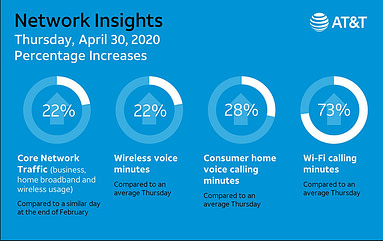
Dear Ms. Smartphone: During the pandemic my phone started to ring more often, and I got nice voice calls from my family on the other coast, from my college roommate, and even from relatives overseas. Now it seems like I am getting less real calls and more fake ones, like robo-calls. I enjoyed catching up with friends on the phone and having long conversations. But, is that over now? Rachel, New York
Dear Rachel: Hopefully people will emerge from the pandemic with a greater appreciation for how to use their phone to renew and sustain relationships. Going forward, you must be willing to initiate those personal calls, as well as receive them. It’s a revival of that old AT&T slogan, “Reach Out and Touch Someone.”
But first, you are spot-on about the frequency of voice calling during the pandemic.
Network Gains:
AT&T reports that between mid-March and May 1, wireless calls (for home and business) peaked at 44% above typical levels and Wi-Fi calling more than doubled. In the same period Verizon experienced about 800 million daily calls, double the number they traditionally handled on Mother’s Day, the busiest calling day of the year.
The pandemic makes us all more aware that relationships are fragile and precious. We worry. And, we seek more direct knowledge and experience by checking in with people from other parts of the country. The sound of a familiar voice is comforting and human.
Voice calls can also fill a vital need, someplace between the digital world and the personal one.
People Gains:
During the pandemic more people are at home and fewer on- the- road, so, to coin another telco slogan, they ‘Let their Fingers do the Walking.’ Lots of family members share a single slow Internet connection, so voice communications is more dependable. Also, people are tired of being online so much so voice calls provide a break.
But, now, as things open up- how do you make the phone calls keep happening? It may depend, in part, on your age group.
Ringing forward…
If your friends are Boomers or older, maybe set up a regular time or routine for a call, say at a fixed time each week. But if that doesn’t suit them, text your friends first, and set up a time to talk, maybe the next hour, or the next day. These days people can answer a phone call anywhere (at the beach, in their car, in the bath) so it makes sense to text first, in advance of a voice call.
Second, if you have younger friends, or kids, think of a different strategy. Perhaps when you call, start with Facetime or a similar video program. But then, as the conversation proceeds, ask if you can switch out to voice. That way you stay current with their technology, and they stay current with you. The pandemic has helped younger people become “less allergic” to voice calling, or maybe just more familiar with it.
Whichever method you find for maintaining voice calls, do not get in the habit of placing these from your car. First, these are vital connections so they deserve your time and attention. And, if it’s meaningful, and life is, don’t risk the cognitive distraction. It’s important to preserve the strong relationships we have developed during the pandemic and do so safely.


Leave a Reply
You must be logged in to post a comment.